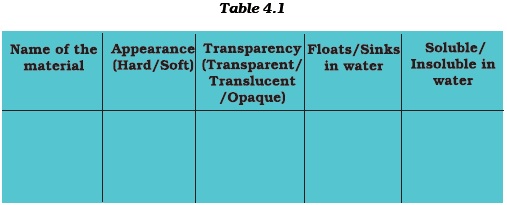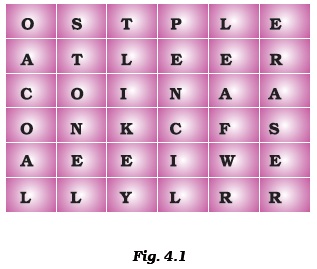Candidates can download NCERT Exemplar Class 6 Science Chapter 4 from this page. The exemplar has been provided by the National Council of Educational Research & Training (NCERT) and the candidates can check it from below for free of cost. It contains objective, very short answer type, short answer type, and long answer type questions. Along with it, the answer for each question has also been provided. From the NCERT Exemplar Class 6 Science Chapter 4, candidates can understand the level and type of questions that are asked in the exam.
NCERT Exemplar Class 6 Science Chapter 4 Sorting Materials and Groups
NCERT Class 6 Science Chapter 4 is for Sorting Materials and Groups. The type of questions that will be asked from NCERT Class 6 Science Chapter 4 are displayed in the below provided NCERT Exemplar Class 6 Science Chapter 4. With the help of it, candidates can prepare well for the examination.
Multiple Choice Questions
- An iron nail is kept in each of the following liquids. In which case would it lose its shine and appear dull?
(a) Mustard oil
(b) Soft drink
(c) Coconut oil
(d) Kerosene - Pick one material from the following which is completely soluble in water.
(a) Chalk powder
(b) Tea leaves
(c) Glucose
(d) Saw dust - You are provided with the following materials
(i) Magnifying glass
(ii) Mirror
(iii) Stainless steel plate
(iv) Glass tumbler
Which of the above materials will you identify as transparent?
(a) (i) and (ii)
(b) (i) and (iii)
(c) (i) and (iv)
(d) (iii) and (iv) - Boojho found a bag containing the following materials
(i) Mirror
(ii) Paper stained with oil
(iii) Magnet
(iv) Glass spectacles
Help Boojho in finding out the material(s) which is/are opaque.
(a) (i) only
(b) (iv) only
(c) (i) and (iii)
(d) (ii) and (iv) - While doing an activity in class, the teacher asked Paheli to handover a transluscent material. Which among the following materials will Paheli pick and give her teacher?
(a) Glass tumbler
(b) Mirror
(c) Muslin cloth
(d) Aluminium foil - Which pair of substances among the following would float in a tumbler half filled with water?
(a) Cotton thread, thermocol
(b) Feather, plastic ball
(c) Pin, oil drops
(d) Rubber band, coin - Which among the following are commonly used for making a safety pin?
(a) Wood and glass
(b) Plastic and glass
(c) Leather and plastic
(d) Steel and plastic - Which of the following materials is not lustrous?
(a) Gold
(b) Silver
(c) Wood
(d) Diamond - Which of the following statements is not true?
(a) Materials are grouped for convenience.
(b) Materials are grouped to study their properties.
(c) Materials are grouped for fun.
(d) Materials are grouped according to their uses. - Find the odd one out from the following
(a) Tawa
(b) Spade
(c) Pressure cooker
(d) Eraser - Which type of the following materials is used for making the front glass (wind screen) of a car?
(a) Transparent
(b) Translucent
(c) Opaque
(d) All the above
Very Short Answer Type Questions
- It was Paheli’s birthday. Her grandmother gave her two gifts made of metals, one old dull silver spoon and a pair of lustrous gold earrings. She was surprised to see the difference in the appearance of the two metals. Can you explain the reason for this difference?
- Mixtures of red chilli powder in water, butter in water, petrol in water, and honey in water were given to Radha, Sudha, Sofia and Raveena, respectively. Whose mixture is in solution form?
- On a bright sunny day, Shikha was playing hide and seek with her brother. She hid herself behind a glass door. Do you think her brother will be able to locate her. If yes, why? If no, why not?
- Take a small cotton ball and place it in a tumbler/bowl filled with water. Observe it for atleast 10 minutes. Will it float or sink in water and why?
Short Answer Type Questions
- Which among the following materials would you identify as soft materials and why?
Ice, rubber band, leaf, eraser, pencil, pearl, a piece of wooden board, cooked rice, pulses and fresh chapati. - You are provided with the following materials— turmeric, honey, mustard oil, water, glucose, rice flour, groundnut oil.
Make any three pairs of substances where one substance is soluble in the other and any three pairs of substances where one substance remains insoluble in the other substances. - During summer holidays, a group of children collected a lump of salt, green grass, broken glass piece, a small thermocol box, pen, iron nail, glass marbles, hair, naphthalene ball, a piece of sugar candy (mishri) and tried to group them on the basis of properties given in Table 4.1 below. Help them in filling the Table.
![Sorting Materials and Groups]()
- Arrange the jumbled words to arrive at the appropriate names of materials and also write two uses of each
(a) milaunuim
(b) tcaslpi
(c) soekrnee
(d) gavnier - Match the objects given in Column I with the materials given in Column II.
![Sorting Materials and Groups]()
- Pick five objects from the word box given as Fig. 4.1 which are opaque and would sink in water.
![Sorting Materials and Groups]()
Long Answer Type Questions
- Chalk, iron nail, wood, aluminium, candle, cotton usually look different from each other. Give some properties by which we can prove that these materials are different.
- Why do you think oxygen dissolved in water is important for the survival of aquatic animals and plants?
- Differentiate among opaque, translucent and transparent materials, giving one example of each.
- Sugar, salt, mustard oil, sand, sawdust, honey, chalk powder, petals of flower, soil, copper sulphate crystals, glucose, wheat flour are some substances given to Paheli. She wants to know whether these substances are soluble in water or not. Help her in identifying soluble and insoluble substances in water.
Click here to download NCERT Exemplar Class 6 Science Chapter 4 Sorting Materials and Groups.
Answers






The post NCERT Exemplar Class 6 Science Chapter 4 Sorting Materials and Groups appeared first on AglaSem Schools.
from AglaSem Schools https://ift.tt/3utqWdH
https://ift.tt/eA8V8J https://ift.tt/eA8V8J



Post a Comment